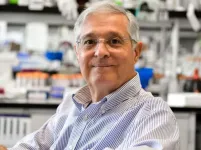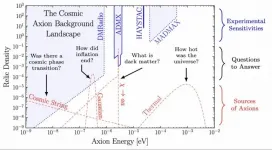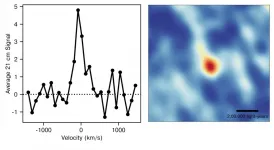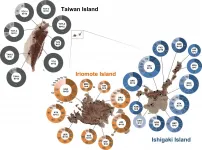Study supports gene therapy as a promising treatment for soft bone disease
A single dose of AAV8-TNAP-D10 may be safe and effective for hypophosphatasia
2021-06-07
(Press-News.org) LA JOLLA, CALIF. - June 7, 2021 - A preclinical study led by scientists at Sanford Burnham Prebys has established that AAV8-TNAP-D10--a gene therapy that replaces a key enzyme found in bone--may be a safe and effective single-dose treatment for hypophosphatasia (HPP). The study, published in the Journal of Bone and Mineral Research and performed in a murine model of the disease, further supports advancing the therapy toward human clinical trials.
"This is the most promising gene therapy study to date demonstrating a successful increase in life span, and improvement of the skeletal and dental abnormalities associated with HPP, without signs of side effects in other organs," says José Luis Millán, Ph.D., professor in the Human Genetics Program at Sanford Burnham Prebys. "We're hopeful that this research will lead to a curative therapy--an alternative for patients who must currently undergo multiple injections of medication per week, often associated with injection-site reactions, to maintain their health."
HPP--also known as soft bone disease--is an inherited, rare bone condition of broad-ranging severity that causes life-threatening disease in approximately one per 100,000 live births. Depending on the severity of the skeletal disease, symptoms can include deformity of the limbs and chest, pneumonia, and recurrent fractures. Although there is currently no cure for HPP, patients may benefit from injections of asfotase alfa--a mineral-targeted form of the missing enzyme called TNAP--which is an FDA-approved therapy based on Millán's more than 20 years of pioneering research on the enzyme and characterized in his laboratory for preclinical efficacy.
The new study evaluated the efficacy of a single intramuscular injection of AAV8-TNAP-D10 in a murine model of infantile HPP. AAV8-TNAP-D10 extended the life span of the mice; and no ectopic calcifications--a potential side effect of the current therapy--were observed in the kidneys, aorta, coronary arteries or brain of the treated mice. AAV8-TNAP-D10 is an adeno-associated virus gene construct that incorporates the gene encoding mineral-targeted TNAP-D10.
"This is a much-needed advance in the field of HPP research," says Deborah Fowler, founder and president of Soft Bones, a leading advocacy group dedicated to the community of patients, caregivers and families living with HPP. "Our patients vary in severity, and there remains a significant unmet need for those unable to receive treatment and those who experience administration challenges with the chronic therapy."
"Our research efforts are committed to improving the lives of people affected by HPP," says Millán. "I'm grateful to the many individuals who enabled this latest study--from the National Institutes of Health, which has generously funded our research since the 1980s, to the collaborators and lab members who are instrumental in our scientific advances. "This work is the culmination of more than 10 years of collaborative efforts with gene therapy experts Professor Takashi Shimada and Dr. Koichi Miyake from Nippon Medical School in Tokyo, to identify the best vector and route of delivery of the TNAP-D10 encoding vector to treat HPP," adds Millán.
INFORMATION:
Additional authors in the current study are Yuka Kinoshita, Amadeu de Oliveria, Sonoko Narisawa at Sanford Burnham Prebys; Fatma F. Mohamed and Brian Foster at The Ohio State University; and Koichi Miyake at the Nippon Medical School, Japan.
The study's DOI is 10.1002/jbmr.4382
This work was funded by grant DE12889 from the National Institute of Dental and Craniofacial Research (NIDCR) of the National Institutes of Health (NIH), and R03DE028411 from NIDCR/NIH and a grant from Soft Bones.
All authors state that they have no conflicts of interest.
About Sanford Burnham Prebys
Sanford Burnham Prebys is a preeminent, independent biomedical research institute dedicated to understanding human biology and disease and advancing scientific discoveries to profoundly impact human health. For more than 40 years, our research has produced breakthroughs in cancer, neuroscience, immunology and children's diseases, and is anchored by our NCI-designated Cancer Center and advanced drug discovery capabilities. For more information, visit us at SBPdiscovery.org or on Facebook at facebook.com/SBPdiscovery and on Twitter @SBPdiscovery.
[Attachments] See images for this press release:

ELSE PRESS RELEASES FROM THIS DATE:
2021-06-07
Monash University researchers have provided a fundamental advance regarding how T cells become activated when encountering pathogens such as viruses.
The recent study published in Science, co-led by Professor Nicole La Gruta, Professor Jamie Rossjohn and Professor Stephanie Gras with first author Dr Pirooz Zareie from the Monash Biomedicine Discovery Institute, have found that T Cells need to recognise pathogens in a particular orientation in order to receive a strong activating signal.
T cells play a key role in the immune system by eliminating invading pathogens, such as viruses, and it is crucial to understand ...
2021-06-07
When we inhale isolated coronavirus particles, more than 65% reach the deepest region of our lungs where damage to cells can lead to low blood oxygen levels, new research has discovered, and more of these aerosols reach the right lung than the left.
Lead author of the study Dr Saidul Islam, from the University of Technology Sydney, said while previous research has revealed how virus aerosols travel through the upper airways including the nose, mouth and throat - this study was the first to examine how they flow through the lower lungs.
"Our ...
2021-06-07
Finding the hypothetical particle axion could mean finding out for the first time what happened in the Universe a second after the Big Bang, suggests a new study published in Physical Review D on June 7.
How far back into the Universe's past can we look today? In the electromagnetic spectrum, observations of the Cosmic Microwave Background -- commonly referred to as the CMB -- allow us to see back almost 14 billion years to when the Universe cooled sufficiently for protons and electrons to combine and form neutral hydrogen. The CMB has taught us an inordinate amount about the evolution of the cosmos, but photons in the CMB were released 400,000 years after the Big Bang making it extremely challenging to learn about the history of ...
2021-06-07
TAMPA, Fla. (June 4, 2021) — Type 1 diabetes (T1D) is an autoimmune disease in which a misdirected immune system gradually destroys healthy pancreatic islet β cells, resulting in a lack of insulin. The exact cause of T1D remains unknown. However, β cell-reactive autoantibodies can be detected in circulating blood months to years before diagnosis, raising the possibility of intervening to stop or delay T1D before children develop the disease.
Monitoring the number, type, and concentration of autoantibodies appearing in the blood can help predict the long-term risk of progression from autoimmunity to symptomatic T1D.
Now new findings suggest that measuring how patterns ...
2021-06-07
A research team from the University of Copenhagen and University of Helsinki demonstrates it is possible to predict individual preferences based on how a person's brain responses match up to others. This could potentially be used to provide individually-tailored media content -- and perhaps even to enlighten us about ourselves.
We have become accustomed to online algorithms trying to guess our preferences for everything from movies and music to news and shopping. This is based not only on what we have searched for, looked at, or listened to, but also on how these activities compare to others. Collaborative filtering, as the technique is called, uses hidden ...
2021-06-07
A team of astronomers from the National Centre for Radio Astrophysics (NCRA-TIFR) in Pune, and the Raman Research Institute (RRI), in Bangalore, has used the Giant Metrewave Radio Telescope (GMRT) to measure the atomic hydrogen gas content of galaxies 9 billion years ago, in the young universe. This is the earliest epoch in the universe for which there is a measurement of the atomic hydrogen content of galaxies. The new result is a crucial confirmation of the group's earlier result, where they had measured the atomic hydrogen content of galaxies 8 billion years ago, and pushes our understanding of galaxies to even earlier in the universe. ...
2021-06-07
Decades of research has revealed the remarkable morphological adaptations of sea snakes to aquatic life, which include paddle-shaped tails, salt-excreting glands, and the ability to breathe through their skin.
In a new study published in Biological Journal of the Linnean Society, researchers at the University of Adelaide detail the enlarged touch receptors that evolved in male turtle-headed sea snakes (Emydocephalus annulatus), to help them locate and court females in aquatic environments.
Lead author, Jenna Crowe-Riddell, PhD graduate at the University of Adelaide's School of Biological Sciences, says on land, snakes use tongue-flicking ...
2021-06-07
Older people need digital skills training to learn to use digital technology more independently, but they also seek digital training opportunities because of the social benefits they offer, according to a recent study from the University of Eastern Finland. Published in International Journal of Lifelong Education, the study examined perceived benefits of digital skills training among older adult learners, their teachers and peer tutors. Data for the study were collected in liberal adult education organisations, such as community colleges, as well as in peer tutoring sessions organised by third sector actors.
New skills and friendships
The coronavirus pandemic has, for its part, highlighted inequalities in the availability and ...
2021-06-07
The Amami, Okinawa region of Japan may be designated a World Heritage Site in July of 2021 based on the recent recommendation from the IUCN. The Iriomote wild cat is a symbolic species of the region, having evolved independently on the island. The area is home to many other highly endemic and unique evolutionary species. A research group comprised mostly of former students of Professor Koji Tojo's Faculty of Science lab of Shinshu University focused on the study of dragonflies, continuing from their previous study of their comparative embryogenesis. About 5,000 species of insects belonging to 26 families of the order Dragonfly are known ...
2021-06-07
A long-standing basic question in biology relates to how life satisfies the fundamental constraints put on it by physics and chemistry. Darwin's warm pond hypothesis for the origin of primordial cells is a familiar one. Advances have been made in mapping out the organic molecules that likely existed on the early Earth, and recently candidate prototypic pathways in early cells have been formulated. But how did these candidates' early biochemistry actually function as a system, on which subsequent cellular life is based?
A team of bioengineers at the Novo Nordisk Foundation Center for Biosustainability, DTU, has now defined ten overarching classes of constraints on early metabolic ...
LAST 30 PRESS RELEASES:
[Press-News.org] Study supports gene therapy as a promising treatment for soft bone disease
A single dose of AAV8-TNAP-D10 may be safe and effective for hypophosphatasia






